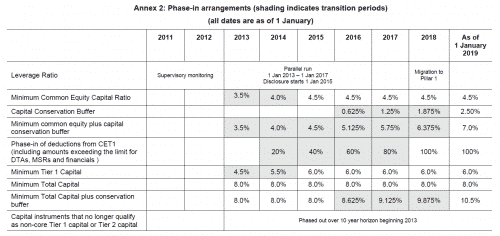Basel III To Tighten Capital Requirements – Eventually
The BIS (Bank for International Settlements) reported Sunday that it has reached an agreement to increase key capital ratios for banks. The announcement was made by the Group of Governors and Heads of Supervision, the oversight body of the Basel Committee on Banking Supervision. The committee is composed of representatives of the top 27 central banks in the world.
The requirements on banks are significant but perhaps not timely. It will take more than half a generation to fully implement. Some provisions will not be completed until 2022.
The minimum requirement for common equity, the highest form of loss absorbing capital, will be raised from the current 2% to 4.5% after the application of stricter adjustments. This will be phased in by 1 January 2015. The total Tier 1 capital requirement, which includes common equity and other qualifying financial instruments based on stricter criteria, will increase from 4% to 6% over the same period. There will also be a “buffer requirement” of 2.5% that can be drawn down to the 4.5% minimum requirement during times of stress. This effectively will raise common equity requirements to 7%.
If a bank draws below the 7% common equity requirement, including the buffer, distribution of earnings must be curtailed until the 7% level is recovered. These restrictions would apply to dividends and executive compensation, including bonuses.
It appears that actual implementation won’t start until 2012 and the accords will not be fully implemented until 2018. Here is the implementation schedule:
According to an article by Brooke Masters in The Financial Times, the UK and the U.S had pushed for earlier implementation (2016). Many countries (including the UK and U.S.) wanted higher Tier 1 capital ratios, up to 10%, but others, most notably Germany, argued for lower ratios, some as low as 4% including buffer. Germany was also on the opposite side of the implementation schedule argument, at one time wanting a 15 year schedule.
It had long been agreed that Tier 3 capital, that bastion of dark capital instruments such as CDS (credit default swaps) and SIV (special investment vehicles), would be eliminated from the capital structure of banks by the Basel 3 accords. Tier 2 capital will remain in the equation (up to 2% of total capital) but just what can be held in tier 2 is uncertain. As shown in the bottom line of the graphic, by 2013 definitions of prohibited instruments will be defined.
It remains to be seen if these redefinitions are actually effect. Won’t this something like a drug addict curing himself? It remains to be seen if these redefinitions are actually effective. Won’t this something like a drug addict curing himself?

Can we agree this is a half-closing of the barn door after the horses have gotten out. Shouldn’t we be looking for the horses?
That is, the banking system remains a zombie sector, adding nothing, extracting wealth, failing to abide by the rules of capitalism while requiring others to do so.
“The requirements on banks are significant but perhaps not timely. It will take more than half a generation to fully implement. Some provisions will not be completed until 2022.”
Where do you get 2022 from? All the Basel III provisions will be fully implented by January 1, 2019, as the implementation schedule shows. That’s about 8 years, since the accords won’t be approved until November. Since when is 8 years “more than half a generation”? A generation is generally 30 years (see e.g. https://dictionary.reference.com/browse/generation).
Yes, the implementation schedule is long. But let’s not exaggerate things. This was the only way we were going to get tough capital requirements. Would you have preferred they cave on core issues (like capping MSRs and DTAs at 15% of Tier 1) in order to get a shorter implementation schedule? I doubt it.
James – – –
Read the bottom line in the table (taken from the Basel III committee report). That calls for definitions of prohibited investments to be phased over 10 years from 2013 to 2023. The accounting rules are for me the most important aspect of banking standards. That gives a implementation span of 12-13 years. Some define generational intervals as 20 years. Hence my statement.
More than half a generation is no exageration.
Edward,
One question for you – sorry if this is a stupid or beginner question, but bank capital isn’t my thing!
> It had long been agreed that Tier 3 capital, that bastion of dark capital instruments such as CDS (credit default swaps) and SIV (special investment vehicles), would be eliminated from the capital structure of banks by the Basel 3 accords.
Exactly what does that mean? Does that mean that banks will continue to be able to keep CDS, SIV’s and similar things completely hidden and off their balance sheets? If so, that seems like it has the potential of a huge potential problem in the making, considering the vast sums of money sloshing around in “dark capital.”
Also, speaking of “dark capital,” does the recent watered-down version of the financial reform act here solve anything, practically speaking?